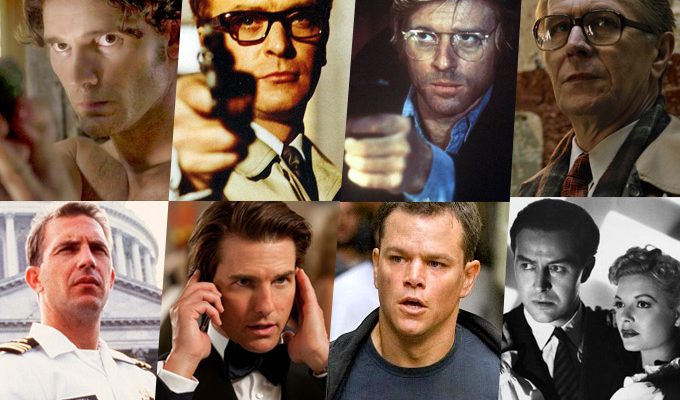 “Our Man In Havana” (1959)
“Our Man In Havana” (1959)
Every time English cinema titan Carol Reed decided to make a movie based on Graham Greene material, he struck gold (see “The Third Man,” and “The Fallen Idol”), but for his last feature-length Greene adaptation, Reed decided to take on material that’s much more irreverent, and in a wholly different register. A witty and sly send-up of spy agencies and their sometimes misguided faith in their intel, “Our Man In Havana” is a droll take on the espionage genre that centers on an expatriate Englishman rube (the great Alec Guinness, whose subtle comedic flair is still grotesquely undervalued) living in pre-revolutionary Havana with his teenage daughter, who is roped into working for the British Secret Service. Inept, ineffectual and in over his head, Guinness’ vacuum cleaner salesman character goes to great lengths to fabricate progress, but it backfires, putting his and his daughters lives in grave danger. Its darker last act is a bit tonally dissonant, but the movie’s bone-dry charms and surprising pointedness still make it a delight.
 “North By Northwest” (1959)
“North By Northwest” (1959)
If Hitchcock invented the ‘wrong man’ sub-genre with “The 39 Steps,” he perfected it with “North By Northwest,” perhaps his most purely entertaining film, if not his very best. Cary Grant plays mild-mannered ad exec Roger Thornhill (surely a touchstone for “Mad Men,”) who finds himself mistaken for a government agent by villainous spy Vandamm (James Mason), and ends up on a wild cross-country chase, much of it with the alluring Eve Kendall (Eva Marie Saint) in pursuit of a microfilm. With the lightest of touches, Hitch (aided by Ernest Lehmann’s witty, airtight screenplay) bounces from memorable set piece to memorable set piece, with each one, from the U.N. assassination to the famous crop duster to the Mount Rushmore conclusion, a classic. It’s flawless filmmaking — the economy of storytelling in the final few shots alone is staggering — and perhaps taken for granted only because the director and peerless cast, especially a definitive Grant, make it look so effortless. After this, Hitchcock mostly abandoned his ‘wrong man’ trope, probably because he was aware it wouldn’t get any better than this — and it really never has.
 “Notorious” (1946)
“Notorious” (1946)
When Ingrid Bergman‘s undercover agent Alicia visits the American offices in Rio, and tells them that their target wants to marry her, the air is thick with innuendo and unspoken yearnings. Cary Grant’s Agent Devlin storms out as bruised lovers are wont to do, and the supervisor comforts Bergman by telling her that “everything has been handled with great intelligence.” The same can be said of every moment of Alfred Hitchcock’s semi-miraculous “Notorious,” which ended up introducing the world to another one of his mastered techniques long before “Vertigo” and “Rear Window” came along: great passion. Romance is a covert operative in this spy film, until it’s revealed to be the grand orchestrator all along. Grant and the silky smooth but devilish Claude Rains (overly attached to his mother like a certain Mr. Bates would be) vie for Bergman’s affections and all three give indelible turns under the auspices of Hitchcock’s singular talents for suspense and intrigue. The result is one of the master’s most emotionally intricate works, featuring that famous walking/swooning embrace in which Grant and Bergman pepper each other with tiny kisses in a deliriously creative sidestepping of the Hayes Code.
 “No Way Out” (1987)
“No Way Out” (1987)
One of those ’80s thrillers that’s been deeply unmodish for a while but deserves to come back into fashion very soon, director Roger Donaldson (“Species,” “The Recruit“) had his finest hour to date with the terrifically suspenseful “No Way Out.” Starring Kevin Costner, Gene Hackman and Sean Young, the film revels in its twisty plot as the US Secretary of Defense (Hackman) brings in a Navy investigator (Costner) to find the other lover of the mistress he’s just passion-killed, so he can frame him as a KGB sleeper agent and accuse him of her murder. He, of course, does not realise that Costner in fact is her other boyfriend, and the plot only thickens from there. Less about international intrigue than about paranoia, moral corruption and betrayal within the walls of the Pentagon, there are some extremely effective set pieces (including a nailbiting dot-matrix printer sequence — seriously), a typically committed Hackman and an ambivalent, charismatic Costner turn that reminds us why he was one of the biggest stars of that era.
 “The Quiller Memorandum” (1966)
“The Quiller Memorandum” (1966)
A rather rote, lumbering plot is injected with pop and fizz by some stunning West Berlin location photography and a brilliant cast in this internationally-flavored spy flick from “Logan’s Run” and “The Dam Busters” director Michael Anderson. George Segal wears the hell out of a suit as Quiller, an American agent tasked by the British Secret Service to investigate a neo-Nazi organisation in 1960s Berlin, but it’s the amazing support that really walk away with the picture. Alec Guinness is the fey but unflappable Pol, who recruits Quiller (they first meet in Berlin’s staggering Olympic Stadium, whose crisp lines are flattered by Erwin Hillier‘s De Luxe cinematography); George Sanders slays in just a couple of scenes as the supercilious puppetmaster back in London; and as the lead neo-Nazi, Max Von Sydow gets to ask Segal “How does it feel to be so sexually attractive?” and pronounces it “seks-ually,” so you know he’s evil as shit. Surprisingly, given how its considerable charms are surface and run no deeper, Harold Pinter adapted the screenplay.

